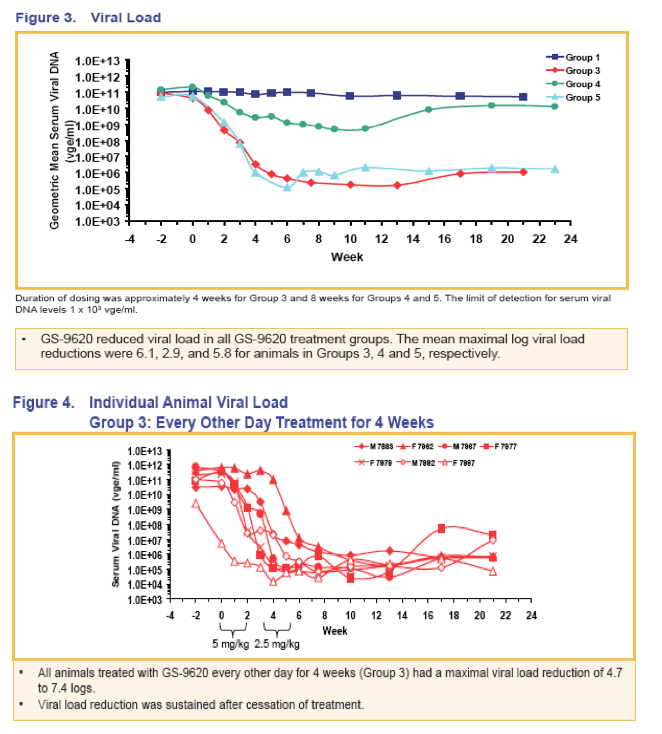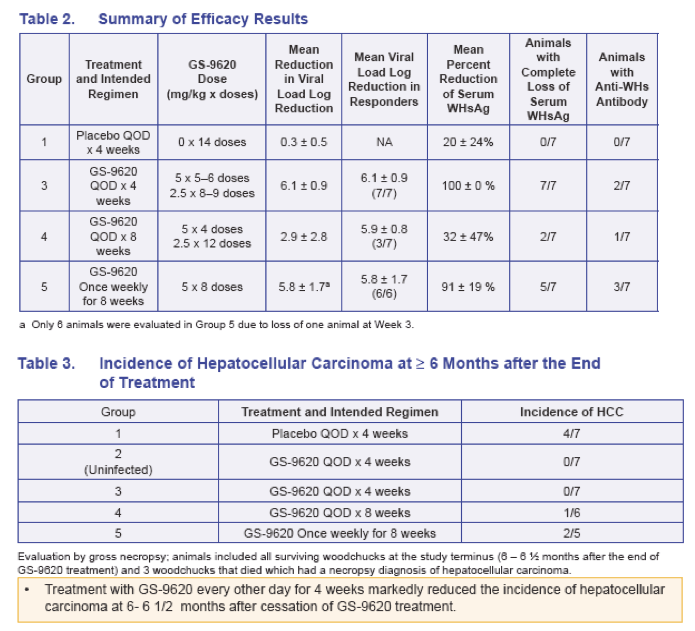 |
 |
 |
| |
Anti-Viral Efficacy and Induction of an Antibody Response Against Surface Antigen with the TLR7 Agonist GS-9620 in the Woodchuck Model of Chronic HBV Infection
|
| |
| |
Reported by Jules Levin EASL 2011 March 31-Apr 2 Berlin Germany
S. Menne1,2, B.C. Tennant2, K.H. Liu2, M.A. Ascenzi2, B.H. Baldwin2, C.A. Bellezza2, P.J. Cote1, X. Zheng3, G. Wolfgang4, D. Tumas4
1Department of Microbiology & Immunology, Georgetown University Medical Center, Washington, DC, 2Department of Clinical Sciences, Gastrointestinal Unit, College of Veterinary Medicine, Cornell University, Ithaca, NY,
3Departments of Drug Metabolism and 4Drug Safety Evaluation, Gilead Sciences, Inc, Foster City, CA, USA.
"GS-9620 reduced viral load in all GS-9620 treatment groups. The mean maximal log viral load reductions were 6.1, 2.9, and 5.8 for animals in Groups 3, 4 and 5, respectively.....All animals treated with GS-9620 every other day for 4 weeks (Group 3) had a maximal viral load reduction of 4.7
to 7.4 logs. Viral load reduction was sustained after cessation of treatment.....GS-9620 reduced serum WHsAg levels and this was sustained after cessation of treatment. Reduction to undetectable levels occurred in 100% of animals treated every other day for 4 weeks (Group 3)..... GS-9620 induced an anti-WHs antibody response in a subset of animals in each treatment group.....Treatment with GS-9620 every other day for 4 weeks markedly reduced the incidence of hepatocellular carcinoma at 6- 6 1/2 months after cessation of GS-9620 treatment."
Safety Results
Single dose PK and PD in uninfected woodchucks
· Mild transient thrombocytopenia, increased body temperature, and lymphopenia occurred at 5 mg/kg.
· 10 mg/kg was not tolerated.
Woodchucks chronically infected with WHV
· Adverse events included changes in clinical pathology parameters and mortality (3 animals).
· Clinical pathology changes included:
- decrease in platelets primarily at the 5 mg/kg dose and sporadically at 2.5 mg/kg
- anemia and increases in liver enzymes (ALT, AST, GGT and SDH) were observed at both doses in some animals in each group
- mild transient increases (0.3 to 0.4 mg/dL) in serum bilirubin in a few animals treated with 5 mg/kg once weekly (Group 5)
· Drug-induced immune inflammatory processes directed at attempted clearance of the chronic WHV infection may have had a causal role for these changes.
· The every other day dose regimen for 4 weeks was the most tolerated.

Introduction
· Though antiviral treatments can suppress Hepatitis C virus (HCV) and Hepatitis B virus (HBV) viral load in chronic infection, novel strategies to enhance long term viral clearance and sustained immunological control represent a signifi cant unmet medical need. Most HBV patients require chronic suppressive antiviral treatment for an indefi nite period.
· GS-9620 is a potent oral TLR7 agonist being developed for the treatment of chronic Hepatitis B and C.
· The goal of GS-9620 treatment is to stimulate an innate antiviral response and enhance an antiviral adaptive immune response.
· Woodchucks chronically infected with woodchuck hepatitis virus (WHV), an animal model for chronic HBV, were treated with oral GS-9620 to investigate its efficacy.
Background
· GS-9620 is an orally active, selective and potent TLR7 agonist that induced IFN-α and select cytokines in vivo with no reduction in pharmacodynamic response with every other day dosing for 4 weeks in cynomolgus monkeys (Poster/Abstract 1776).
· Oral GS-9620 treatment for 8 weeks in chimpanzees chronically infected with HBV reduced serum and liver viral DNA with a mean reduction in serum viral load of 2.2 logs. Treatment induced dose dependent increases in serum interferon-α (IFN-α), interferon-stimulated genes (ISGs) in PBMCs and liver, and activation of lymphocyte subsets (CD8+ T and NK cells) (Oral/Abstract 1771).
· GS-9620 was well tolerated in an oral single ascending dose study at doses up to 12 mg in healthy volunteers and had pharmacodynamic effects beginning at 2 mg. (Poster/Abstract 664).





References
1. Menne S, Butler SD, George AL, Tochkov IA, Zhu Y, Xiong S, Gerin JL, Cote PJ, Tennant BC. Antiviral effects of lamivudine, emtricitabine, adefovir dipivoxil, and tenofovir disoproxil fumarate administered orally alone and in combination to woodchucks with chronic woodchuck hepatitis virus infection. Antimicrob Agents Chemother. 2008 Oct;52(10):3617-32. Epub 2008 Aug 1.
2. Cote PJ, Roneker C, Cass K, Schödel F, Peterson D, Tennant B, De Noronha F, Gerin J. New enzyme immunoassays for the serologic detection of woodchuck hepatitis virus infection. Viral Immunol. 1993 Summer;6(2):161-9.
3. Menne S, Cote PJ, Butler SD, Toshkov IA, Gerin JL, Tennant BC. Immunosuppression reactivates viral replication long after resolution of woodchuck hepatitis virus infection. Hepatology. 2007 Mar;45(3):614-22.
This study was supported by contract N01-AI-05399 (College of Veterinary Medicine, Cornell University) and contract HHSN272201000011I (Georgetown University Medical School) from the National Institute of Allergy and Infectious Diseases (NIAID)
|
| |
|
 |
 |
|
|